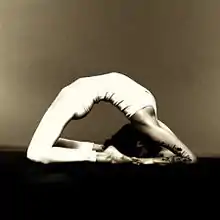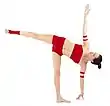Kapotasana
Kapotasana (Sanskrit: कपोतासन; IAST: Kapotāsana) or Pigeon Pose[1] is a kneeling back-bending asana in modern yoga as exercise.

Etymology and origins
The name comes from the Sanskrit words kapota (कपोत) meaning "pigeon"[1] and asana (आसन) meaning "posture" or "seat".[2]
A different (standing) pose is given the name Kapotasana in the 19th century Sritattvanidhi.[3] The modern pose is described in the 20th century in Light on Yoga.[4]
Asanas based on King Pigeon pose or Rajakapotasana[5] are sometimes called Pigeon; for example, Yoga Journal describes a reclining (prone) variation of Eka Pada Rajakapotasana, One-Legged King Pigeon pose, as Pigeon.[6]
Description
A pose from the Ashtanga tradition is an advanced asana which resembles Chakrasana, or Wheel Pose. The shins and forearms are on the ground, the front body stretched upwards in the air. The pose is reached by going into a backbend with knees on the ground. It requires flexibility to bring the head back until it reaches the ground. Kapotasana is an asana which helps to open up the chest and also strengthens the back and groin. It opens and increases the flexibility of the hips,[7] at the same time strengthening the back, and stretching the thighs and the groin.
In Iyengar Yoga, practitioners begin by lying in Supta Virasana, bending the arms and placing the arms beside the head. They then press the hands, exhale and raise the hips and trunk. The crown of the head can be placed on the floor, and hands can be walked towards the feet by raising the trunk higher.[8]
Claims
Twentieth century advocates of some schools of yoga, such as B. K. S. Iyengar, made claims for the effects of yoga on specific organs, without adducing any evidence.[9][10] Iyengar claimed that this pose toned up "the entire spinal region" by making the blood "circulate well round the spinal column"; that it kept the genitals healthy since it stretched the pelvic region; and "massage[d] the heart gently" by lifting the diaphragm.[11]
See also
References
- "Kapotasana A - AshtangaYoga.info". Archived from the original on 2011-04-08. Retrieved 2011-04-09.
- Sinha, S. C. (1996). Dictionary of Philosophy. Anmol Publications. p. 18. ISBN 978-81-7041-293-9.
- Sjoman, Norman E. (1999) [1996]. The Yoga Tradition of the Mysore Palace. Abhinav Publications. p. 77; plate 10, pose 57. ISBN 81-7017-389-2.
- Iyengar, B. K. S. (1979) [1966]. Light on Yoga: Yoga Dipika. Thorsons. pp. 367–372. ISBN 978-1855381667.
- Iyengar, B. K. S. (1979) [1966]. Light on Yoga: Yoga Dipika. Thorsons. pp. 389–399. ISBN 978-1855381667.
- Rizopoulos, Natasha (16 July 2008). "The King of Hip Openers: Pigeon Pose". Yoga Journal.
- "How To Pop Your Hip Or Crack Your Hip". Retrieved 2018-05-16.
- Mehta, Shyam (1990). Yoga the Iyengar Way. Dorling Kindersley. p. 144. ISBN 978-0863184208.
- Newcombe 2019, pp. 203-227, Chapter "Yoga as Therapy".
- Jain 2015, pp. 82–83.
- Iyengar 1979, p. 372.
Sources
- Iyengar, B. K. S. (1979) [1966]. Light on Yoga: Yoga Dipika. Unwin Paperbacks. ISBN 978-1855381667.
- Jain, Andrea (2015). Selling Yoga : from Counterculture to Pop culture. Oxford University Press. ISBN 978-0-19-939024-3. OCLC 878953765.
- Newcombe, Suzanne (2019). Yoga in Britain: Stretching Spirituality and Educating Yogis. Bristol, England: Equinox Publishing. ISBN 978-1-78179-661-0.
_from_Jogapradipika_1830_(detail).jpg.webp)
